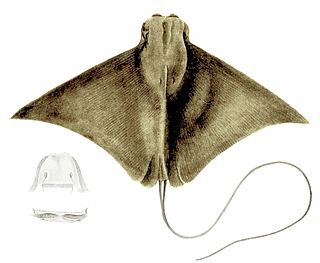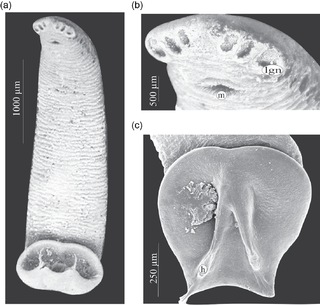
The Scorpaeniformes are a diverse order of ray-finned fish, including the lionfishes and sculpins, but have also been called the Scleroparei. It is one of the five largest orders of bony fishes by number of species, with over 1,320.

Stingrays are a group of sea rays, a type of cartilaginous fish. They are classified in the suborder Myliobatoidei of the order Myliobatiformes and consist of eight families: Hexatrygonidae, Plesiobatidae, Urolophidae (stingarees), Urotrygonidae, Dasyatidae, Potamotrygonidae, Gymnuridae and Myliobatidae . There are about 220 known stingray species organized into 29 genera.

Lungfish are freshwater vertebrates belonging to the class Dipnoi. Lungfish are best known for retaining ancestral characteristics within the Osteichthyes, including the ability to breathe air, and ancestral structures within Sarcopterygii, including the presence of lobed fins with a well-developed internal skeleton. Lungfish represent the closest living relatives of the tetrapods. The mouths of lungfish typically bear tooth plates, which are used to crush hard shelled organisms.

A sawshark or saw shark is a member of a shark order bearing a unique long, saw-like rostrum edged with sharp teeth, which they use to slash and disable their prey. There are eight species within the Pristiophoriformes, including the longnose or common sawshark, shortnose sawshark, Japanese sawshark, Bahamas sawshark, sixgill sawshark, African dwarf sawshark, Lana's sawshark and the tropical sawshark.

The cownose ray is a species of Batoidea found throughout a large part of the western Atlantic and Caribbean, from New England to southern Brazil. These rays also belong to the order Myliobatiformes, a group that is shared by bat rays, manta rays, and eagle rays.

The brownspotted grouper, also known as the brown spotted reef cod, brown-spotted rockcod, coral grouper or honeycomb cod, is a species of marine ray-finned fish, a grouper from the subfamily Epinephelinae which is part of the family Serranidae, which also includes the anthias and sea basses. It has an Indo-Pacific distribution but in the northern Indian Ocean this distribution is discontinuous. It forms part of a species complex with two closely related species in the genus Epinephelus.

The Brazilian cownose ray, also commonly called the Ticon cownose ray, is a species of fish in the family Rhinopteridae. Its range extends along the coast from the southern tip of Brazil to western Florida. Its natural habitats are shallow seas, estuarine waters, and intertidal flats.

Rhinoptera is a genus of ray commonly known as the cownose rays. This genus is the only member of the family Rhinopteridae.

The flapnose ray or Javanese cownose ray is a species of fish in the family Rhinopteridae. It is found in the Indo-Pacific off China, India, Indonesia, Iran, Japan, Madagascar, Malaysia, Mozambique, Pakistan, the Philippines, Seychelles, Somalia, South Africa, Sri Lanka, Taiwan, Tanzania, Thailand, Vietnam and possibly Australia. Its natural habitats are open seas, shallow seas, subtidal aquatic beds, coral reefs, estuarine waters, and coastal saline lagoons.

The golden cownose ray or Pacific cownose ray is a species of ray. It is found in the East Pacific along the coast of Colombia, Costa Rica, Ecuador, El Salvador, Guatemala, Honduras, Mexico, Nicaragua, Panama, and Peru. Its natural habitats are open seas, shallow seas, subtidal aquatic beds, estuarine waters, intertidal marshes, and coastal saline lagoons. They are often in schools, and sometimes associated with the spotted eagle ray.

Thalassina is a genus of mud lobsters found in the mangrove swamps of the Indian Ocean and western Pacific Ocean. Its nocturnal burrowing is important for the recycling of nutrients in the mangrove ecosystem, although it is sometimes considered a pest of fish and prawn farms.

The Mary River flows in the Northern Territory of Australia and is a site of the Mary River National Park.

Lutjanidae, or snappers are a family of perciform fish, mainly marine, but with some members inhabiting estuaries, feeding in fresh water. The family includes about 113 species. Some are important food fish. One of the best known is the red snapper.

Batoidea is a superorder of cartilaginous fishes, commonly known as rays. They and their close relatives, the sharks, comprise the subclass Elasmobranchii. Rays are the largest group of cartilaginous fishes, with well over 600 species in 26 families. Rays are distinguished by their flattened bodies, enlarged pectoral fins that are fused to the head, and gill slits that are placed on their ventral surfaces.

Monocotylidae is a family of monogenean flatworms.
The rough cownose ray is a species of eagle ray in the genus Rhinoptera.

Rhinoptera marginata, the Lusitanian cownose ray, is a species of ray found along the western coast of Africa and Mediterranean Sea. It is apparently rare in the Mediterranean Sea, but is common in shallow waters off the western Africa.
Euzetia lamothei is a flatworm which parasitizes the gills of the cownose ray. It is named after Dr. Marcos Rafael Lamothe Argumedo, a professor at Universidad Nacional Autónoma de México who has done research on Monogeneans. The species averages 405 micrometers long by 178 micrometers wide. It can be distinguished from its closest relative, Euzetia occultum, based on size and the morphology of the reproductive organs.
Euzetia is the only genus in the subfamily Euzetiinae, a group of flatworms which parasitize Elasmobranchs. As of 2008, only two species have been described in the genus, however others may remain undescribed. The genus consists of Euzetia occultum, which is the type species for the genus, and Euzetia lamothei, which was described in 2008. E. occultum parasitizes the Australian cownose ray, Rhinoptera neglecta, while E. lamothei parasitizes a different species in the same genus, the cownose ray, Rhinoptera bonasus. Both species inhabit the gills of their respective hosts. The genus is differentiated from other genera based on the morphology of the haptor, and is named for the French parasitologist Louis Euzet.
Rhinoptera neglecta, the Australian cownose ray, is a species of the Rhinopteridae family. It is found in the Western Pacific Ocean from Queensland to New South Wales in Australia. The species is 86 centimeters long.














